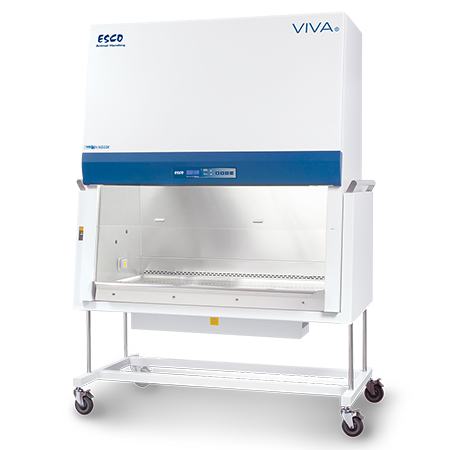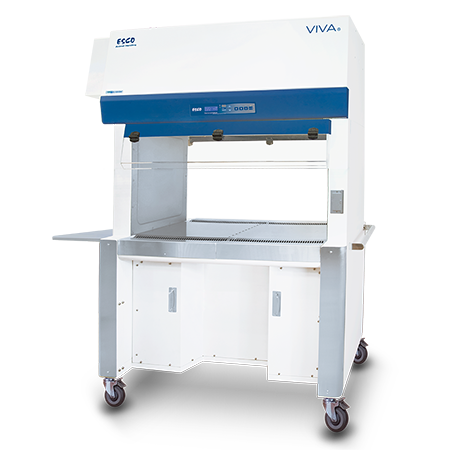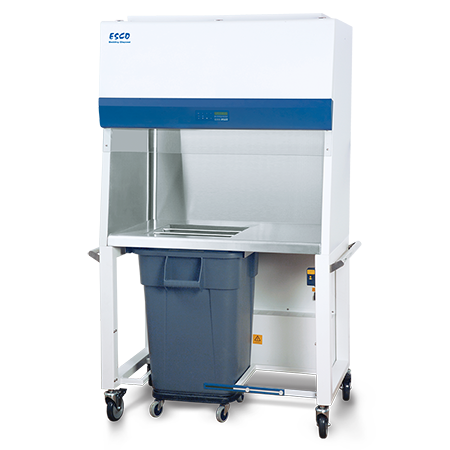I. Introduction
An animal research workstation is necessary for handling animals during clinical researches. It provides user protection from hazardous microorganisms, toxins, allergens, anesthetic gases, and physical injuries— as well as environment protection from waste and odors. It is vital to identify the must-have features for the workstation to attain optimal protection needed during cage changing, bedding disposal, and animal transfer procedures.
II. Animal Research Workstation Guide to Models
| Animal Research Workstation | VIVA® Universal Animal Containment VA2-E  | VIVA® Dual Access Animal Containment VDA  | VIVA® Bedding Disposal Animal Containment VBD  | |
|---|---|---|---|---|
| Primary Application | Research procedures | Cage changing | Bedding disposal from soiled cages after changing | |
| Available Sizes | 4 ft and 6 ft | 4 and 5 ft | 4 ft | |
| Allergen Control | Yes, ELISA-proven | |||
| Biohazard Protection | Yes | No | ||
| Certifications | UL | N/A | Yes | |
| CE | Yes, CE declaration of conformity | |||
| EN 12469 | Yes | N/A | ||
| Filtration | Main Filters | Dual ULPA filters (exhaust and downflow) | Carbon filter + ULPA filter | |
| Pre-filter | Disposable and non-washable polyester fibers with 85% arrestance / Impregnated activated carbon pre-filter | |||
| Controller | Sentinel™ Gold microprocessor | Sentinel™ Silver microprocessor | ||
| Blower | DC ECM | Dual DC ECM | AC centrifugal motor fan | |
| Airflow System | Recirculating, 40% exhaust & 60% downflow | “Push-pull” recirculating | Total exhaust | |
| Work Zone |
|
|
| |
| Primary Accessories |
|
|
| |
III. Must-have Features of an Animal Research Workstation
ELISA-verified containment that provides protection against allergen
Low noise level for quiet operation, comfort for user and animals
Equipped with energy-efficient blower
Cost-effective ULPA filter with ISO Class 3 work-zone
Intuitive and ergonomic controller
Stable airflow with monitoring system
Comfortable legroom
Antimicrobial coating
Accessories and wide range of model options
IV. Factors When Buying an Animal Research Workstation
The main purpose of an animal research workstation is to provide operator protection when handling animals during clinical research. There are multiple types of animal research workstations, and it is important to choose the right model according to your application needs.
Factors to consider when purchasing an Animal Research Workstation
Durability
Performance
Low maintenance cost
Energy efficiency
Ergonomics
Wide and easy access work area
Filter efficiency
Value for money
ADA-compliance
After-sales service
Longer warranty period
ELISA-verified for user protection against allergens
Typical questions to ask before buying
What application/s would the animal research workstation be used for?
Does the personnel require protection from biohazardous samples?
What is the preferred work surface material and construction?
What is the preferred controller type?
What is the airflow configuration? Does it include an airflow monitoring system?
What are the primary operational accessories needed?
How much is the installation cost and how difficult is it to install?
How much is the operational cost?
What is the required workstation size?
Will it fit in the lab?
Will the unit fit on hallways, doors, elevators, and other paths?
Reasons to purchase a new one
Setting up a new laboratory facility
Replacing an old and less efficient unit that has a high operational cost
Defective unit due to electronics or mechanical malfunctions
Animal research workstation repeatedly failed the certification which means it's no longer safe to use
Additional unit due to an increase in laboratory works
V. Safety Tips When Using an Animal Research Workstation
According to the US National Institute for Occupational Safety and Health (NIOSH):
Allergic reactions are among the most common conditions that adversely affect the health of personnel involved in the care and use of animals in research.
Symptoms of allergies include sneezing, nasal congestion, itchy eyes, and cough.
Some personnel may even develop asthma or other respiratory disorders.
Personnel should protect themselves from exposure to animals and animal products.
Seek medical attention in case allergy symptoms develop.
Animal handlers should take steps to protect themselves from exposure to animals and animal products:
Perform animal manipulations within ventilated workstations or safety cabinets when possible.
Avoid wearing street clothes while working with animals.
Leave work clothes at the workplace to avoid potential exposure problems for family members.
Keep cages and animal areas clean.
Reduce skin contact with animal products such as dander, serum, and urine by using gloves, lab coats, and approved particulate respirators with face shields.
Cage Changing Recommendations for Small Animals
Utilize an Animal Containment Workstation which protects both animals and personnel.
Plan the work session and prepare all items required before starting work.
Turn on the fan and wipe down the work surface with a suitable disinfectant.
Remove cages from the ventilated rack(s) and change them one at a time in the workstation.
Spray your gloved hands with disinfectant before removing the rodent from a dirty cage.
Remove the rodent by holding the mid-base of its tail and transfer it to a clean cage. If there is more than one rodent in the cage, transfer the rodents one at a time.
Handle animals with care, as inappropriate handling may provoke an animal response and result in possible injury and discomfort.
Ensure the feeder and water bottle are properly secured.
Return the clean cage to the correct slot in the ventilated rack system.
After all cages are changed, perform a final animal count and verify all rodent cages are properly secured in the ventilated rack(s).
Wipe the work surface with suitable disinfectant and turn off the fan.
Log all activities as required by your facility.
Bedding Disposal Recommendations
If possible, wet down all dirty cages before dumping soiled bedding.
Dump all soiled bedding in a suitable Bedding Disposal Workstation.
Dispose of soiled bedding and other laboratory waste according to your facility’s guidelines.
Maintenance
Workstations and safety cabinets should be recertified by trained technicians at least once every 12 months.
Disclaimer: Esco does not in any way recommend or promote animal testing. Alternatives to animal testing are available and are currently being developed.

